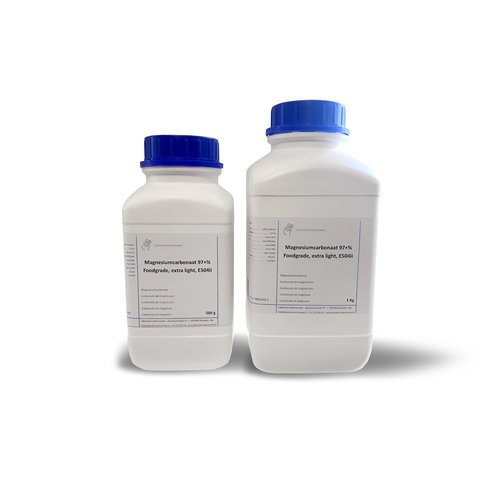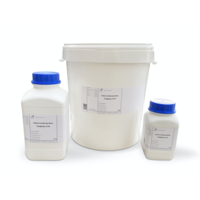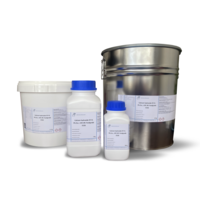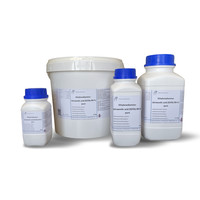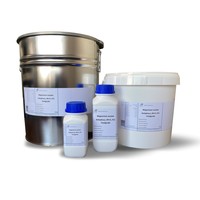You have no items in your shopping cart
Magnesium carbonate 99+% food grade, E504
- Buy 2 and save 5%
- Buy 6 and save 10%
What is Magnesium Carbonate?
Magnesium carbonate (MgCO3) is a white solid found in nature in mineral form. In powder form, magnesium carbonate is used in many sports as an antiperspirant, known as magnesia.
What is magnesium carbonate used for?
-Adsorber
Due to the large specific surface of 800 m²/g, Upsalit (anhydrous nano-magnesium carbonate) is suitable as an adsorber for air dehumidifiers and the binding of oil to water. Research is also being done into an application as a carrier material for pharmaceutical substances, in which use is made of the controllability of the pore size.
-Food additive
In the food industry, magnesium carbonate is added to foodstuffs as an acidity regulator, carrier or separating agent. It is considered harmless to health, but large amounts can have a laxative effect.
In the EU it is approved as an additive with the number E504 without a maximum quantity restriction for all foods that may contain additives. This also includes organic products.
-Insulation and filling material
It is used in thermal insulation materials and as a filler in plastics, paper, paints and rubber and in cosmetics in powders.
-Sport
Magnesium carbonate is sold by the manufacturers under the names Magnesium Carbonate, Magnesia or Chalk. The product is used by gymnasts, strength athletes and climbers to dry hand perspiration and thus increase the grip of the hands and the ability to slide on the equipment bars. It is available in pressed block form, as a loose powder and recently also as a liquid suspended in alcohol (so-called liquid chalk, English liquid.
Sport climbing
It was first used in sport climbing by John Gill for bouldering who brought with him the idea of apparatus gymnastics.
The magnesia is transported in sealable, portable bags, so-called chalk bags. They are attached to the climbing harness at the rear, at the level of the coccyx. Once the climber gets their hands wet while climbing, they can reach into the opened bag. Magnesia is usually also used preventively so that the hands cannot get wet at all. The chalk bag is usually filled directly with powder or blocks that have been ground into powder. Alternatively, you can also carry a chalk ball in the bag. These are thin and permeable fabric balls filled with magnesium oxide, which have the advantage of lower consumption and reduced dust production. Since dust can be a problem in climbing gyms, there are some hall regulations that only allow chalk balls and prohibit open magnesia.
In some climbing areas, such as in Saxon Switzerland, the use of magnesia is not allowed or at least undesirable for several reasons:
The magnesium carbonate residues remaining in the handles “pull” water from the environment (hygroscopy), making the handles permanently moist/slippery and making climbing without magnesium oxide difficult.
The "attracted" water collects in certain types of rock (e.g. sandstone), when it freezes it gains volume and can thus destroy the rock surface.
It leads to optical deterioration of the rock surface (white spots on the rocks). Colored magnesia is also available for this use.
It causes a long-lasting change in the physical and chemical properties of the rock (reduction of friction, chemical conversion of the minerals). Critics argue that this only applies to the sandstone and that it is mainly based on assumptions.
Conservation: Magnesia acts as a basic fertilizer in larger quantities, but effects on rock soil, flora and fauna have not yet been scientifically proven.
Reduction of the sporting requirements: The marking of the handles on the rock, achieved consciously or as a side effect of using magnesia, makes them easier to find, reducing the sporting challenge.
Apparatus gymnastics and strength training
In gymnastics and strength training, the magnesium oxide is placed in containers near the place of performance. The athletes then dry their palms in it before starting their exercise so that their skin does not stick too tightly when gripping the bars of parallel bars or the iron bars of horizontal bars or barbell.
-Refractory products
Refractory materials are made from magnesite in the steel and iron industry (steel ladles or electric furnaces), but also in the cement or glass industry (lining of rotary kilns or glass melting furnaces). When heated, the magnesite is converted to magnesium oxide, releasing carbon dioxide. The largest and most important manufacturer in the world is RHI AG, which evolved from the Veitsch-Radex Group. The magnesite deposits are distributed all over the world. In Austria, magnesite is currently being mined and processed directly in the Breitenau and Hochfilzen.
Magnesite is an aggregate or the only raw material for technical ceramics, for refractory crucibles and sticks. Here the magnesite is converted into magnesia ceramics during firing or is pre-fired and used as powdered magnesia.
Buy magnesium carbonate?
You can buy magnesium carbonate of the highest quality at Laboratoriumdiscounter. Not only a fair price but also delivered quickly. Foodgrade Magnesium carbonate with volume discount!
Technical data
Magnesium carbonate
Empirical formula MgCO3
Melting point (mp) ≥300°C
WCK 1
CAS no. [546-93-0]
EC-No. 235-192-7
Downloads

